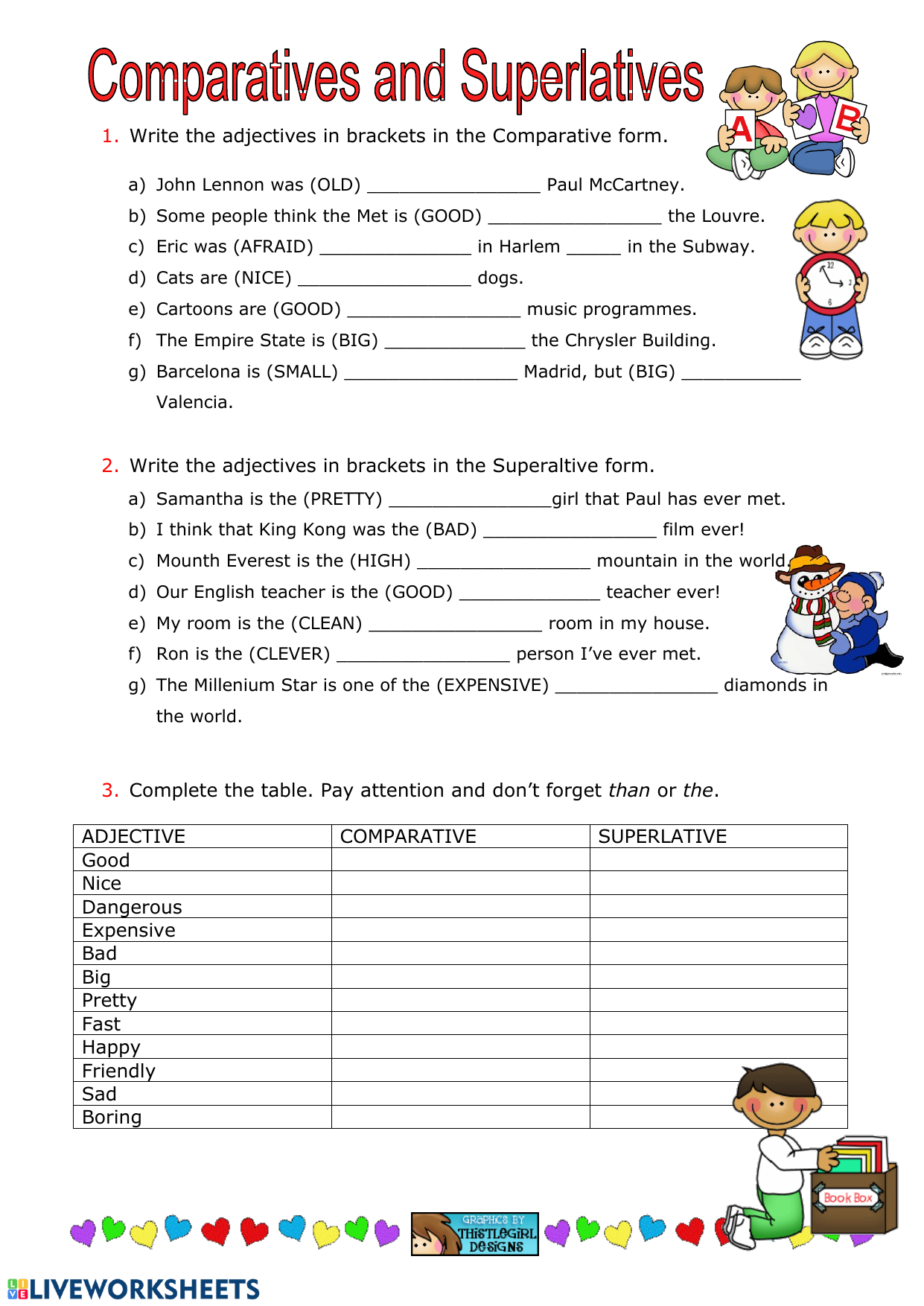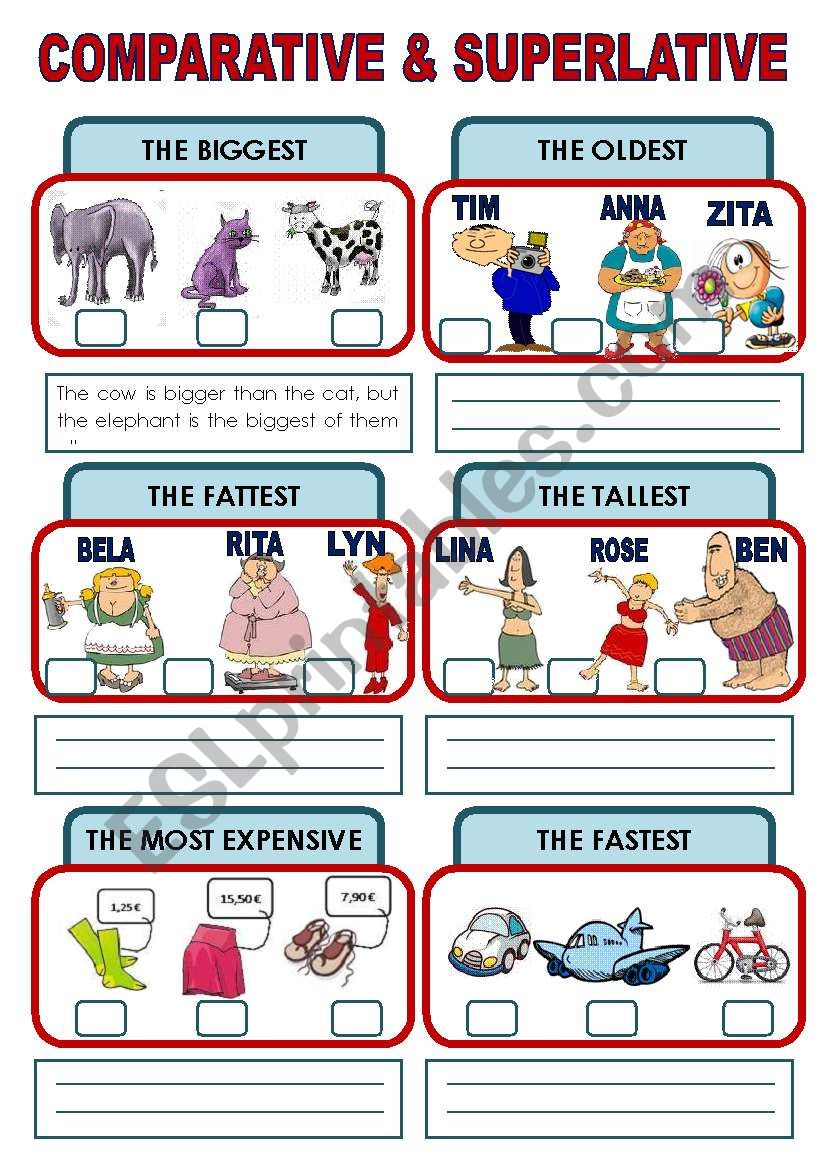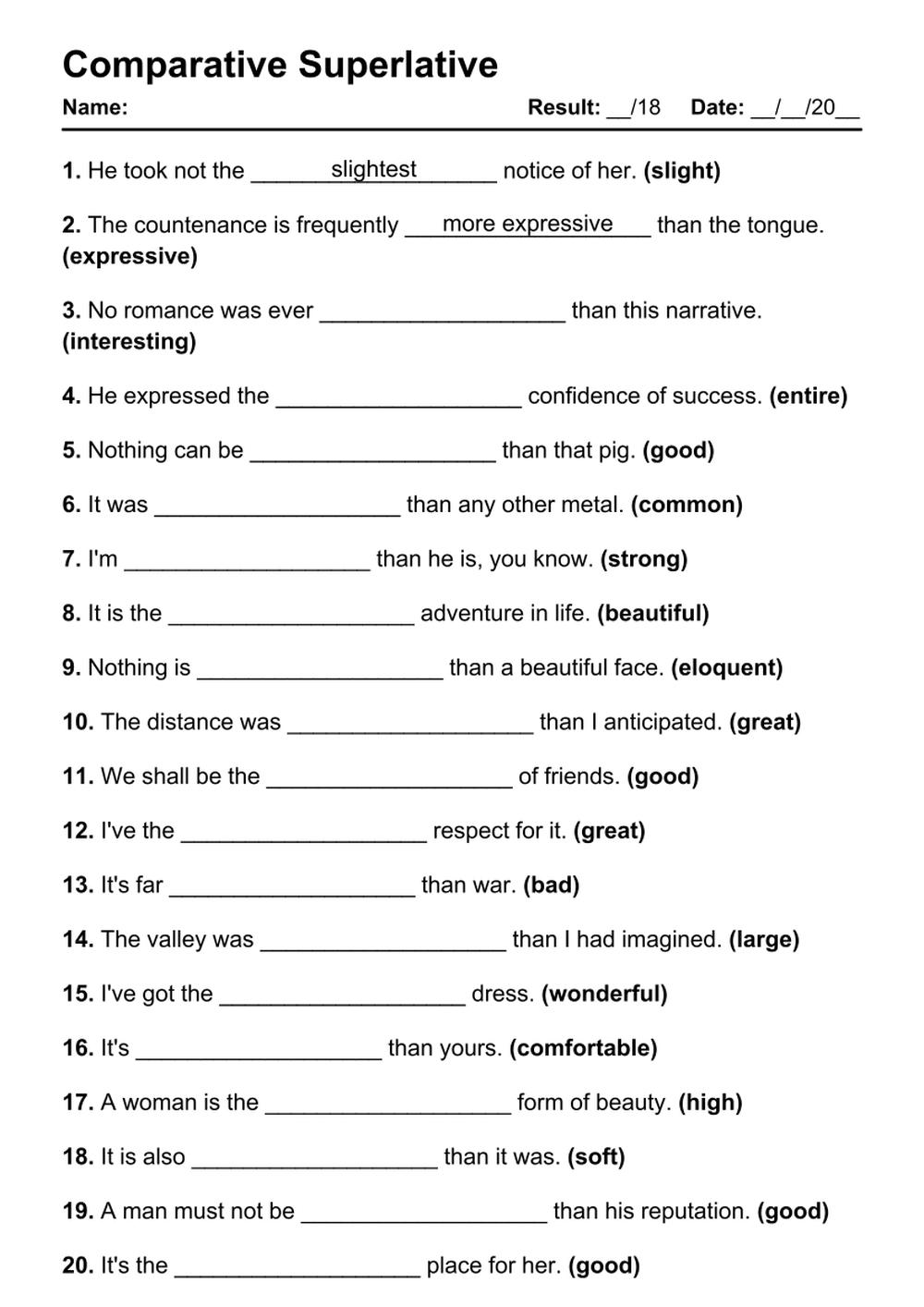
Mastering Degrees of Comparison: The Indispensable Role of Comparative and Superlative Test Worksheets
English, a language rich in nuance and expressiveness, often requires speakers and writers to articulate degrees of difference or superiority. This is where comparative and superlative forms of adjectives and adverbs become indispensable. They allow us to say that one thing is "taller" than another, or that something is "the most beautiful" of all. While the concepts might seem straightforward, mastering their correct usage, including irregular forms and spelling rules, often presents a significant challenge for language learners. This is precisely where comparative and superlative test worksheets emerge as an invaluable educational tool.
These worksheets are not merely collections of exercises; they are structured learning instruments designed to reinforce understanding, identify areas of weakness, and build confidence in applying these crucial grammatical structures. This article will delve into the profound importance of comparative and superlative test worksheets, exploring their benefits, the types of exercises they offer, the grammatical rules they reinforce, and how educators and learners can best utilize them to achieve mastery.

The Foundational Grammar: Comparative and Superlative Forms

Before diving into the worksheets themselves, it’s essential to briefly recap the core concepts.

- Comparative forms are used to compare two things, people, or groups. They typically involve adding "-er" to short adjectives/adverbs (e.g., taller, faster) or using "more" before longer ones (e.g., more intelligent, more carefully). The word "than" almost always accompanies the comparative form (e.g., "He is taller than his brother").
- Superlative forms are used to compare three or more things, people, or groups, indicating the highest or lowest degree of a quality. They usually involve adding "-est" to short adjectives/adverbs (e.g., tallest, fastest) or using "most" before longer ones (e.g., most intelligent, most carefully). The definite article "the" typically precedes the superlative form (e.g., "She is the most intelligent student in the class").


The complexity arises with irregular forms (e.g., good/better/best, bad/worse/worst, far/farther/farthest) and specific spelling rules (e.g., doubling the final consonant, dropping the final ‘e’). These nuances necessitate focused, repetitive practice that worksheets are perfectly suited to provide.
Why Are Worksheets So Effective for Mastering Comparatives and Superlatives?
The efficacy of comparative and superlative test worksheets stems from several pedagogical advantages:

- Structured Practice: Worksheets provide a systematic way to practice. They often start with simpler exercises and gradually increase in difficulty, allowing learners to build foundational knowledge before tackling more complex scenarios.
- Immediate Feedback: When accompanied by answer keys, worksheets offer instant verification of correctness. This immediate feedback loop is crucial for learning, as it allows learners to understand their mistakes and correct them promptly, preventing the reinforcement of incorrect usage.
- Identification of Weaknesses: By analyzing common errors on worksheets, learners and educators can pinpoint specific areas where understanding is lacking—whether it’s irregular forms, spelling rules, or the correct use of "than" or "the." This allows for targeted intervention and further practice.
- Variety of Exercises: Good worksheets offer diverse exercise types, preventing monotony and engaging different learning styles. This variety ensures comprehensive understanding, moving beyond simple memorization.
- Reinforcement of Rules: Repetitive exposure to the rules through various exercises helps solidify them in the learner’s mind. This active recall and application are far more effective than passive memorization.
- Self-Paced Learning: Worksheets can be used independently, allowing learners to progress at their own speed. This is particularly beneficial for differentiated instruction, where students might have varying levels of proficiency.



Types of Comparative and Superlative Test Worksheets
The versatility of comparative and superlative test worksheets lies in the wide array of exercise formats they can employ. Each type serves a unique purpose in the learning process:
-
Gap-Fill Exercises: These are perhaps the most common and serve as an excellent starting point. Learners are given sentences with blanks where they need to insert the correct comparative or superlative form of a given adjective or adverb.
- Example: My dog is (big) __ than yours. (bigger)
- Example: She is (fast) __ runner in the class. (the fastest)
-
Sentence Transformation: These exercises require learners to rewrite sentences, changing the degree of comparison. This often involves converting a positive statement into a comparative or superlative one, or vice-versa. This type of exercise demands a deeper understanding of sentence structure and meaning.
- Example: Rewrite: "John is tall." into a comparative sentence comparing him to Mike. (John is taller than Mike.)
- Example: Rewrite: "This is the most expensive car." into a positive statement. (This car is very expensive.)
-
Error Correction: Learners are presented with sentences containing grammatical errors related to comparatives and superlatives. They must identify and correct these mistakes. This develops critical thinking skills and helps learners recognize common pitfalls.
- Example: Incorrect: "She is more taller than her sister." (Correct: She is taller than her sister.)
- Example: Incorrect: "He is the most good student." (Correct: He is the best student.)
-
Picture-Based Activities: These visually engaging worksheets use images to prompt comparisons. Learners might compare two objects in a picture using comparatives or identify the most prominent feature among several using superlatives. This is especially helpful for visual learners and younger students.
-
Contextualized Passages/Stories: Rather than isolated sentences, these worksheets embed comparative and superlative forms within short paragraphs or stories. This helps learners understand how these forms function in a natural linguistic context, improving reading comprehension and application.
-
Sentence Construction/Creative Writing Prompts: Learners are given a set of adjectives/adverbs and asked to create their own sentences using their comparative and superlative forms. This encourages creativity and active production of language.
-
Multiple Choice Questions: While less demanding, multiple-choice questions can be useful for quick assessments or as a warm-up activity, testing recognition of correct forms.
Key Grammatical Rules Reinforced by Worksheets
Effective comparative and superlative test worksheets systematically address and reinforce the various rules governing these forms:
- One-syllable adjectives/adverbs: Adding -er for comparative (e.g., old – older) and -est for superlative (e.g., old – oldest).
- Two-syllable adjectives ending in -y: Changing ‘y’ to ‘i’ and adding -er/-est (e.g., happy – happier – happiest).
- Adjectives/adverbs with two or more syllables: Using "more" for comparative (e.g., beautiful – more beautiful) and "most" for superlative (e.g., beautiful – most beautiful).
- Irregular forms: Memorizing and applying forms like good/better/best, bad/worse/worst, far/farther/farthest (or further/furthest), little/less/least, and much/many/more/most.
- Spelling rules: Such as doubling the final consonant before adding -er/-est (e.g., big – bigger – biggest) or dropping the final ‘e’ (e.g., large – larger – largest).
- The use of "than": Consistently linking the comparative form to the object of comparison.
- The use of "the": Preceding the superlative form to denote uniqueness or highest degree.
- Distinguishing adjectives from adverbs: Ensuring learners understand when to modify a noun (adjective) versus a verb, adjective, or another adverb (adverb).
Designing and Selecting Effective Comparative and Superlative Test Worksheets
For educators creating their own materials, or for learners seeking out resources, certain characteristics define high-quality comparative and superlative test worksheets:
- Clarity of Instructions: Simple, unambiguous instructions ensure learners understand what is expected of them.
- Gradual Difficulty: Worksheets should ideally progress from simpler recognition tasks to more complex production and error correction exercises.
- Variety of Exercise Types: As discussed, a mix of formats keeps learners engaged and ensures comprehensive understanding.
- Relevance and Engagement: Using examples and contexts that are relatable and interesting to the target audience can significantly boost motivation.
- Inclusion of Answer Keys: Essential for self-correction and independent learning.
- Visual Appeal: Well-organized layouts, clear fonts, and appropriate use of images can make worksheets less daunting and more inviting.
- Targeted Practice: Focus on one or two specific rules per section before mixing them, to avoid overwhelming the learner.
Integrating Worksheets into the Learning Process
Worksheets can be effectively integrated at various stages of the learning process:
- Pre-assessment: Use a short worksheet to gauge students’ existing knowledge before teaching the topic.
- In-class Practice: Provide worksheets for guided practice immediately after introducing new rules.
- Homework: Assign worksheets for independent reinforcement and review outside of class.
- Review and Reinforcement: Use them periodically to ensure long-term retention of the rules.
- Differentiated Instruction: Provide different levels of worksheets to cater to varied proficiency levels within a classroom.
- Self-Study: For independent learners, worksheets are an excellent way to learn and practice at their own pace.
Common Pitfalls and How Worksheets Address Them
Learners frequently make specific mistakes when using comparatives and superlatives. Worksheets are tailored to address these common pitfalls:
- Double Comparatives/Superlatives: A frequent error is using both "-er" and "more," or "-est" and "most" (e.g., "more taller," "most fastest"). Error correction exercises on worksheets specifically target this.
- Incorrect Irregular Forms: Misremembering or misapplying irregular forms (e.g., "gooder," "baddest"). Repeated practice with specific irregular forms in gap-fills and sentence creation helps solidify the correct usage.
- Confusion of Adjectives and Adverbs: Using comparative/superlative adjective forms where an adverb is needed, or vice versa (e.g., "He runs more quick," instead of "more quickly"). Worksheets can provide exercises that force this distinction.
- Misuse of "than" and "the": Omitting "than" after a comparative or "the" before a superlative. Gap-fill exercises specifically designed to insert these articles/conjunctions are effective.
- Spelling Errors: Errors like not doubling consonants or not dropping ‘e’. Worksheets focusing on these specific spelling rules through completion exercises can be very helpful.
Beyond the Worksheet: A Holistic Approach
While comparative and superlative test worksheets are undeniably powerful tools, it’s crucial to remember they are part of a broader language learning ecosystem. For true mastery, they should be complemented by:
- Speaking practice: Engaging in conversations where comparisons are naturally made.
- Writing tasks: Incorporating comparative and superlative forms into essays, descriptions, and stories.
- Listening comprehension: Identifying these forms in spoken English (movies, podcasts, conversations).
- Interactive games and activities: Making learning fun and collaborative.
Conclusion
In the journey of mastering English grammar, the precise and accurate use of comparative and superlative forms is a hallmark of proficiency. Comparative and superlative test worksheets stand out as a foundational resource in this endeavor. They offer structured, targeted, and varied practice that reinforces complex rules, addresses common errors, and empowers learners with the confidence to express nuanced comparisons effectively. By strategically integrating these worksheets into their study routines, both educators and students can ensure a robust understanding and application of these essential grammatical structures, paving the way for clearer, more expressive communication.
